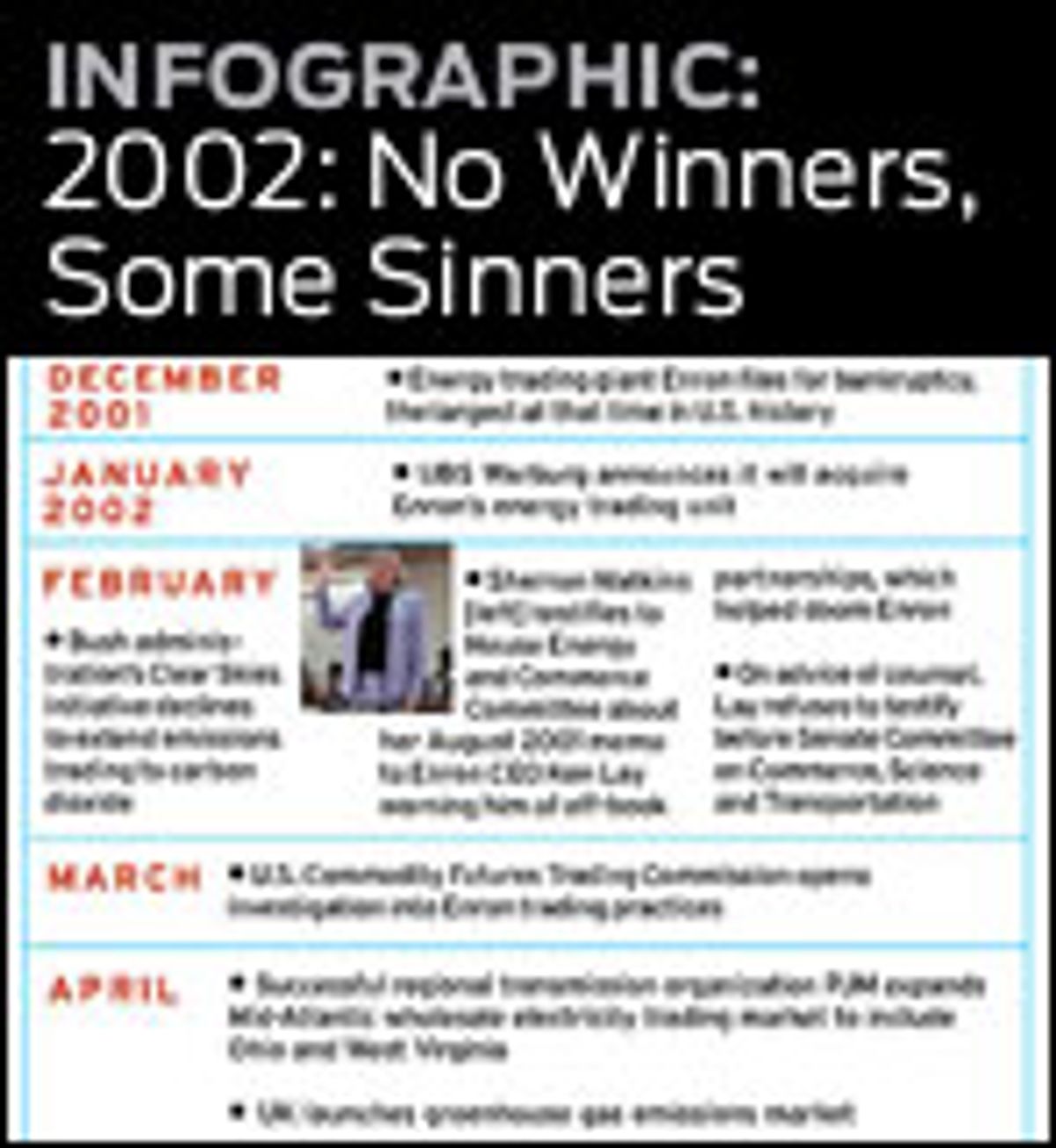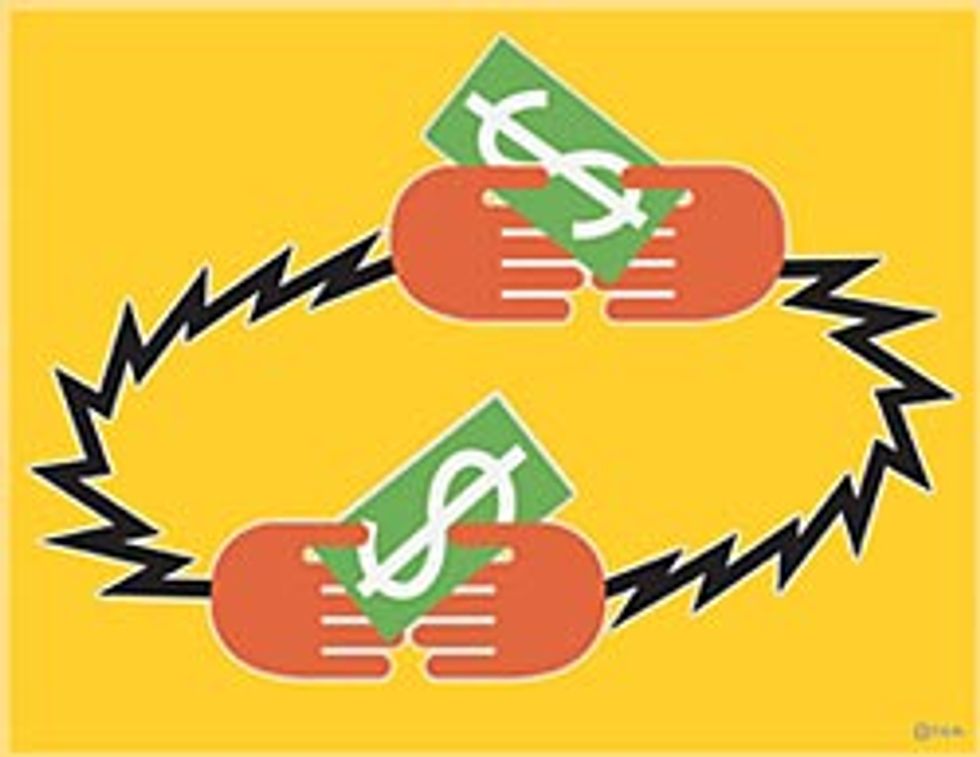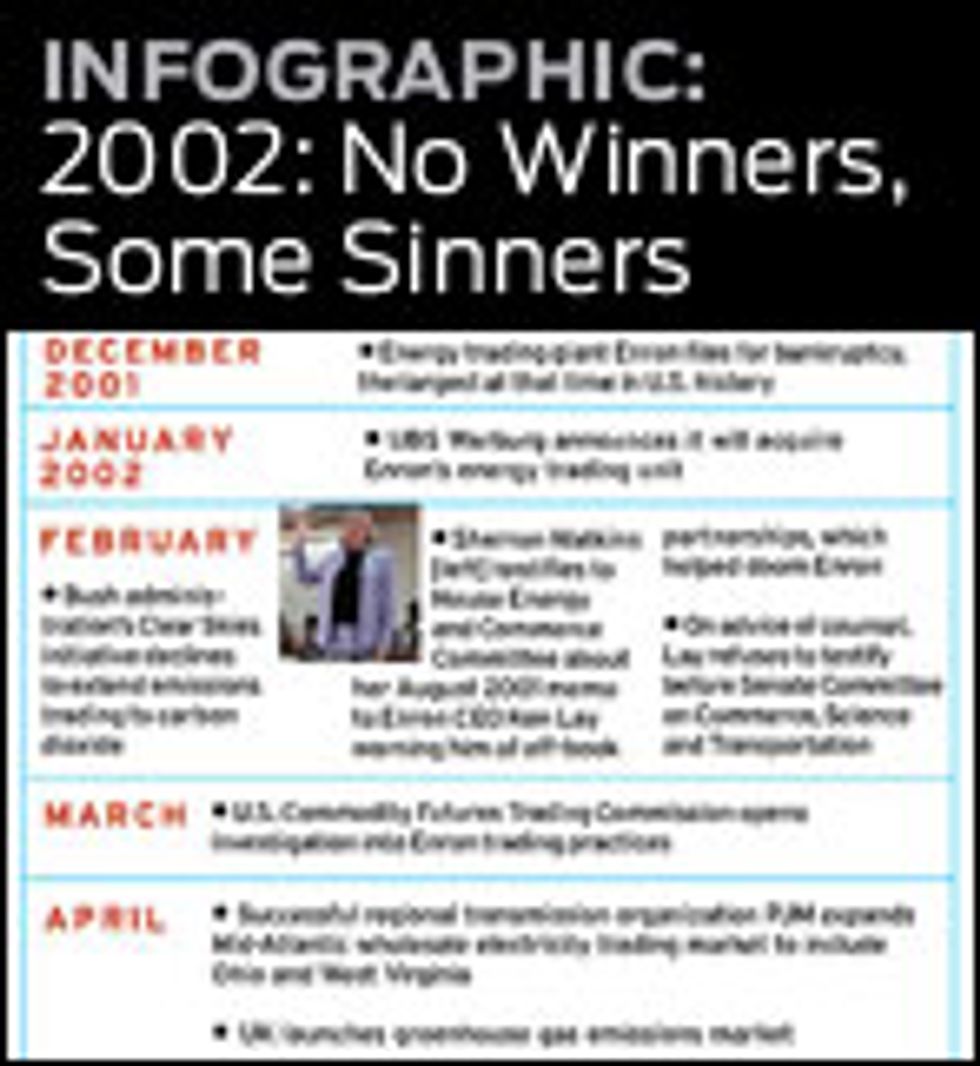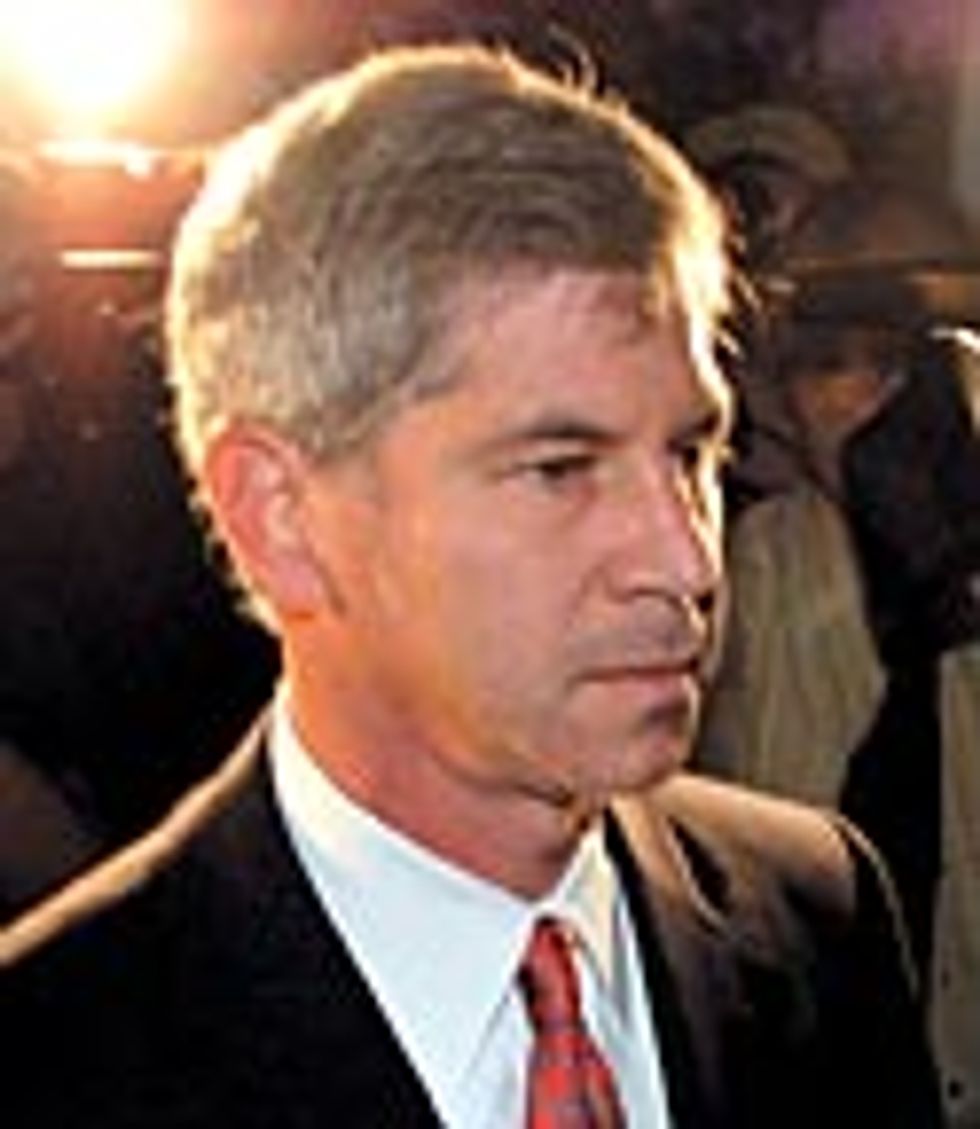Opening Up Energy Trading
Market manipulation, self-dealing, and round-trip transactions by a small circle of players gave nascent U.S. electricity markets a bad name

This is part of IEEE Spectrum's special report: What's Wrong—What's Next: 2003 Technology Forecast & Review.
On 3 October 2001, Enron Corp.'s chief executive officer Ken Lay was in his element, chairing a day-and-a-half, invitation-only conference on national energy policy at a swanky hotel just outside Washington, D.C. It was wall-to-wall policy types, just the sort of gathering in which the Ph.D. economist reveled.
The giant Houston-based company once again was doing well in the stock market. It had recovered from a bad dive it took after the mysterious resignation of Jeff Skilling as CEO, which had forced founder Lay to resume the day-to-day management of the company, the most admired in the United States for several years running, according to Fortune magazine surveys. The future looked bright for Enron and its rivals in the intensely competitive business of selling electricity, natural gas, and financial products based on energy prices.
In the previous decade, energy trading had emerged as the fulcrum of efforts to restructure electricity markets not only in the United States--something of a Johnny-come-lately to the game--but also in the United Kingdom, Norway, New Zealand, and Chile. The general idea was that transmission systems would be made open-access, rather like the restructured long-distance telephone system in the United States, and any generator of electricity would be entitled to sell into the system.
Distributors of electricity, the classic utilities, would be stripped of generation and transmission assets and would purchase electricity wholesale on the open market. Brokers, relying on the most advanced Web-based communications, would play a key role as intermediaries, getting electricity from places it was in surplus to the places it was needed most. Among such brokers, Enron was seen as the world leader--highly skilled, absolutely sure of itself to the point of arrogance, and immensely profitable.
Yet in hindsight, it's apparent that Lay's top-of-the-world posture at the D.C. policy conference in October 2001 was truly his last moment in the sun. Two months later Enron was in bankruptcy, and four months later Lay would decline to testify to Congress on the advice of his attorney. There followed a drumbeat of funereal news from the energy trading business: self-dealing with specially created entities to hide losses from balance sheets and create dubious profits, bogus round-trip trades executed only to inflate apparent revenue, deals made to create transmission congestion that then would be relieved by follow-on sales of electricity at inflated prices, and withholding of generating capacity and natural gas supplies to also inflate prices [see Timeline, facing page].
By last fall, a year after Lay's D.C. conference, the electricity business looked like the Gettysburg battlefield, the day after. Among the dead or mortally wounded: the public-private California Power Exchange, the Arthur Andersen accounting firm, Enron itself, and the energy trading unit of its fellow trading pioneer in Houston, Dynegy. The walking wounded included generating companies such as AES and Calpine, and utilities that got burned in electricity trading like CMS Energy, Reliant Energy, and Allegheny Energy, not to mention two of California's three huge electricity distributors: investor-owned Pacific Gas and Electric Co. (PG and E) and Southern California Edison.
Under California's seriously defective restructuring plan, the state's three utilities had found themselves in an unhealthy position--having to buy electricity wholesale at inflated so-called free-market prices while having to sell retail at much lower regulated prices. The result was almost instantaneous bankruptcy for PG and E and near-bankruptcy for Southern California Edison.
Enron is now a dirty word, embodying the corporate malfeasance that allowed executives to walk off with millions, while investors and employees saw their life savings go down the tubes. What happened? And what needs to be done to make electricity trading the transparent and honest business it must be if energy is to be produced and distributed to best economic effect?
The fall of the house of Enron
Ironically, the events that led directly to Enron's collapse had little directly to do with its energy trading business. The beginning of the end was the discovery in October 2001 by Wall Street Journal reporters of some strange partnerships Enron's chief financial officer, Andrew Fastow, had created, apparently with his board's approval, in order to move debt off its public books and boost its publicly reported profits. These special-purpose entities, which happened to be hugely profitable to Fastow personally, turned out to be the financial termites that ate away Enron's foundation.
At a stroke, Enron's shocking downfall tore the blinders off regulators and watchdogs, causing sudden sharp scrutiny of the entire energy trading industry. First to be affected were the energy traders themselves, the firms that buy and sell contracts for electricity and gas in over-the-counter (off-exchange) markets. These contracts are purely financial instruments, derivatives that reflect the price of something else, such as electricity, and are used to hedge against future losses as prices change. It soon came to light that some of the biggest-name firms in the business--Reliant Energy, CMS Energy, Dynegy--had engaged in the fake transactions known variously as round-trip or "wash" trades.
The financial markets now decided that energy and electricity trading was risky business. The leading credit raters, Moody's, Standard and Poor's, and Fitch, coming under criticism for not having been skeptical enough in the salad days of trading, responded harshly, downgrading not only the traders but also merchant generators--companies that own generating plants and sell the electricity into the competitive wholesale market.
Soon, only the distribution utilities still had investment-grade bond ratings. But by fall 2002, even some of those came under heavy attack, as the taint of Enron spread to almost every company involved in making, selling, and distributing electricity. Initially, only California's PG and E and Southern California Edison had been in trouble, caught in regulatory pincers not particularly of their making. Now, partly because electricity trading was beginning to work better in many other parts of the country and internationally, utility distributors and merchant generators were seeing profits fall because prices were coming down sharply.
The complex California connection
At a meeting of the IEEE's Power Engineering Society in Vancouver, B.C., Canada, in July 2001, attendees reacted with considerable skepticism to arguments made by California regulators and economists that generators had withheld power during the 2000-01 Western energy crisis to drive prices higher.
All such good-willed disbelief was swept away by a smoking gun internal memo that emerged early in the Enron investigations. It outlined a series of manipulative trading transactions with names like "Get Shorty," "Ricochet," and "Death Star," and detailed ways Enron's traders had manipulated the California market to get top dollar for power the company was selling into the state.
It would be tempting to conclude that electricity trading in general or Enron in particular was single-handedly responsible for the California debacle. But, in fact, unexpectedly rapid growth in demand, an unusual shortage of generation (driven in part by a bad year for hydro in the Pacific Northwest), and some legitimate disconnection of generators for maintenance purposes also played important roles. Most important of all, California's poorly conceived restructuring plan was a setup for market manipulation and magnified the imbalance when manipulation occurred. An ill-advised ban on long-term power purchases put utilities at the mercy of the spot market, and when prices on that market skyrocketed, the ceiling set by the state on retail prices left them unable to recover costs.
Arguably, then, "Enron's actions [only] make it [more] difficult to sort out how much of California's problems were real and how much were due to illegal market manipulation," says John Rowe, chairman of Chicago-based Exelon Corp. Energy economist Jonathan Falk, vice president at NERA, the highly regarded consultancy with offices in New York City and London, went so far as to argue that "the majority of Enron's strategies" actually corrected design flaws in the California market, sometimes to good local effect.
However that may be, the general effect of trading misconduct was clearly devastating. What was behind that misconduct, aside from obvious personal greed? Why did chief executives, boards, and auditors turn a blind eye?
David Penn, executive vice president at the American Public Power Association (Washington, D.C.), pinpoints the insatiable need to demonstrate rapid growth in a business that in fact was not growing all that quickly. Penn may somewhat overstate his case. As U.S. energy demand grew at a faster pace than expected in the 1990s while generating capacity largely stagnated, reserve margins, traditionally on the order of 18 percent, shrank everywhere [see "Restructuring the Thin-Stretched Grid," IEEE Spectrum, June 2000, pp. 43-49]. As a result, electricity trading grew much faster than the sector as a whole, because increasingly power had to be transferred over long distances to avert shortages.
But even so, trading apparently did not grow fast enough to satisfy traders like Enron that their performance, on its own merits, would be impressive enough to satisfy investors, creditors, or even their own customers. The whole business depended on faith that if a broker promised to deliver a certain amount of electricity at a certain date, the broker would actually be in a position financially to deliver.
Confidence, says Massachusetts Institute of Technology energy economist Richard Tabors, is the resource that energy trading depends on. And now "there is a tremendous lack of confidence on the part of financial markets."
Credit risk and price transparency
In testimony before the Senate Committee on Energy and Natural Resources in January, Vincent Viola, chairman of the New York Mercantile Exchange Inc. (NYMEX, New York City), explained how over-the-counter energy markets differ from the NYMEX, where trades are regulated by the Commodities Futures Trading Commission (CFTC, Washington, D.C.). "The trading subsidiary of Enron, EnronOnline, was, prior to the parent's financial failure, a marketplace for physical delivery of energy products [meaning that buyers and sellers actually intend to make or take delivery of the commodity bought or sold] and also for unregulated financial instruments called 'swaps,'" which look very much like conventional NYMEX futures contracts.
Trouble Signs
U.S. National Energy Legislation has languished for a year, and when it finally passes, may not have teeth. Meanwhile, efforts by the Federal Energy Regulatory Commission to muscle the utility industry to self-organize into regional transmission organizations continue to encounter resistance
Much-touted Flexible AC Transmission Systems (FACTS) , expected to expand efficient trading, remain confined to expensive demonstration projects
Electricity Prices in the pioneering British market, once considered too high because of a generator duopoly, now may be too low, prompting some suppliers to drop out altogether
Wish List
Timely completion and wide acceptance of IEEE's Interconnection Standard (P 1547) for connecting distributed generation and energy storage assets to the grid
Ubiquitous Electricity Metering , permitting consumers of electricity, residential as well as industrial and commercial, to adjust their usage to changing prices in real time
Accelerated use of ENERGY-STORAGE technologies such as superconducting flywheels, so that more electricity can be saved for peak demand periods
NYMEX, however, is a clearinghouse, structured to protect all participants against credit risk, namely, the possibility that either one of the two parties to a transaction fails to pay funds as they become due. But in the electricity trading market:
- The buyers and sellers each bear the credit risk for each other; if one defaults, the other pays.
- Pricing is not transparent to the public--that is, prices agreed upon by traders are not published as trades take place.
- The transactions are not regulated by the CFTC, and Congress has refused to change this.
NYMEX has traded gas futures for years. When Enron tanked, Viola told the committee, much of the volume of gas trading from EnronOnline moved over to NYMEX. But this couldn't happen with electricity because when NYMEX tried in the mid-1990s to build an electricity trading market, it could not attract enough customers.
In gas trading, NYMEX publishes prices negotiated for futures, which traders in the unregulated over-the-counter gas markets can test against the prices they see quoted in the trade press. Not so with electricity, where the Federal Energy Regulatory Commission (FERC, Washington, D.C.) has found strong circularity in prices: the trade press got its price data from traders, who got their information from Enron, which based its posted prices on trade publications--which, it turns out, were often being supplied by traders grinding axes.
Standardizing market structures
FERC has authority over interstate trading in gas and electricity, which it has exercised with a very light hand. But as that trading plays an ever-greater part in the energy sector, the importance of the commission has naturally grown, relative to the authority of state regulatory commissions.
Last August it proposed a standard market design for transmission markets, to minimize incompatible rules in neighboring jurisdictions and smooth transactions crossing seams between jurisdictions. While the proposal has run into some opposition, particularly in the Northwest and the South, where authorities have regarded electricity restructuring as a bad idea to begin with, FERC is likely to prevail by accommodating somewhat different market designs that meet the special conditions of those regions.
FERC's standard market design is mainly built on the successful framework of PJM Interconnection LLC (Norristown, Pa.), the large regional transmission organization that serves much of the Mid-Atlantic states from New Jersey to Ohio [see "PJM Interconnection: Model of a Smooth Operator," Spectrum, June 2000, pp. 50-55]. A power exchange and independent system operator rolled into one, PJM does not give suppliers the opportunity to play one party off against the other, the way they did in California.
On another front, FERC is moving to bolster confidence with tighter financial accounting requirements. In late October, it proposed revisions to its accounting rules to clear up the way companies report liabilities associated with retiring assets, such as closing power plants.
Not least, since President George W. Bush made his Texas confidante Pat Wood III the chairman of FERC, early in 2001, the commission has shown willingness to intervene much more forcefully to clean up the California mess.
Does energy trading have a future?
Until quite recently, with the exception of gadfly organizations such as Ralph Nader's Public Citizen or the Consumers Union, publisher of Consumer Reports, hardly anybody doubted that electricity deregulation was here to stay. Critiques of the basic idea, on the rare occasions they appeared in industry publications, sometimes were published anonymously. But in the wake of the Enron and California debacles, that situation has changed some.
Unsung Hero
Hardly anybody had a tougher time during the western U.S. power crisis of 2000-01 than STEVEN J. WRIGHT, administrator of the Bonneville Power Administration. Water levels were critically low, while the rates it paid for power were skyrocketing. Working with utilities and industrial customers to slash demand, Wright helped shave their load by an average of 2277 MW.
Under Fire
In Spectrum's recent survey of IEEE Fellows [see "Since You Asked..."], over 40 percent strongly disagreed with the statement that "energy deregulation in the United States will advance energy technology development," which 45 percent considered the most important technology issue of the day.
Meanwhile, an article in the November issue of Electricity Journal, a top utility publication, by a team of energy economists at Carnegie Mellon University, called the whole idea of energy trading into question. From an analysis of the California, PJM, and New York electricity markets, they concluded that individual players would be able to easily control prices much of the time, and that the costs of any measures taken to make that impossible might well outweigh the benefits gained from deregulation [see To Probe Further, below].
Such arguments may be compelling yet remind one of a philosopher's observation that the doctrine of free will, however often or effectively it is knocked down, just keeps coming back. Certainly many people were naive about what it would take to make energy deregulation and electricity trading work. But though the ideas may be seriously flawed, the process appears to have gone too far, and had too much invested in it, to be reversed now.
Quite simply, trading has become "a critical element" of the electricity business, says Richard McMahon, group director at the Alliance of Energy Suppliers, an Edison Electric Institute (EEI, Washington, D.C.) subsidiary that represents the merchant electricity sector. "It is needed, at a minimum, just to manage risk," he points out, as well as to obtain the needed electricity from the most efficient sources.
Confidence, says MIT energy economist Richard Tabors, is the resource that energy trading depends on. And now "there is a tremendous lack of confidence on the part of financial markets"
Given that electricity must be moved to where it's most needed, there is simply no clear alternative to trading. The answer, accordingly, is to tighten regulation to make trading transparent and honest. Bush made a start with the appointment of Wood, and Congress could do more if it made some voluntary self-regulation mandatory.
In order to facilitate trading, EEI has led an industry group that developed a master agreement for power purchase and sale. Known as the master contract, it provides real-time credit provisions and standardizes product definitions.
"Trading is still going on, the markets are working," observes MIT's Tabors, one of the new order's apostles. "Enron was only 15 percent of the market, as big as it was."
Looking abroad to the United Kingdom, which preceded the United States in restructuring its electricity markets by several years, the picture is notably improved. Initially, some loopholes allowed generators to manipulate the system to push up prices. So recently, the UK replaced the pool with what it calls the New Energy Trading Arrangement (NETA), which relies more on bilateral deals than on bidding into a central pool.
Tech Watch
The E-Terra Trade family of energy software developed by Alsthom Esca is geared to both market players and market managers, such as independent system operators (ISOs) and regional transmission organizations (RTOs).
Software designed to help suppliers formulate and submit bids is being integrated into standard energy management systems, like those Alsthom widely supplies. Tools suitable for ISOs and RTOs include secure HTML-based visualization systems, enabling markets to be evaluated from different points of view, plus a trademarked market clearing system
Dark Horse
SEN Engineering Solutions (Monroeville, Pa.) has a novel concept for power system control. The brainchild of IEEE members (and spouses) Kalyen K. Sen and Mey Ling Sen, the idea is to rely on TRADITIONAL TRANSFORMER-AND-TAP TECHNOLOGY to regulate and minimize reactive power in transmission lines--the current that is out of phase with voltage and contributes nothing to useful energy delivered. Their Sen transformers would accomplish much the same things as more sophisticated but much more expensive flexible AC transmission systems (FACTS) devices. For example, they argue a simple transformer with thyristor-controlled taps could regulate reactive power just as well as thyristor-controlled capacitor banks
The result has
been salutary for the market, although the much lower wholesale prices have generators grousing. A recent report by the International Energy Agency (IEA, Paris, France) concluded that NETA has been "a breakthrough towards a fully competitive electricity generation market," producing a 20-25 percent drop in wholesale electricity prices and an even larger drop in retail electricity prices. Said the report, the UK's "pioneering role in electricity market reform HAS ALLOWED it to reap the benefits of free and open markets. Retail markets have dropped 30 percent in real terms since 1990 and the market is truly competitive, with 38 rival companies vying for business at the wholesale and retail levels." Over 100 000 electricity customers now switch suppliers in Britain each week.
To Probe Further
See "Market Power in Deregulated Wholesale Electricity Markets," by Seth Blumsack, Dmitri Perekhodtsev, and Lester B. Lave, Electricity Journal, November 2002, pp. 11-24.
Also informative is "Lessons to Be Learned from California and Enron for Restructuring Electricity Markets," by Michael D. Smith, Electricity Journal, August-September 2002, pp. 23-32.
Check out "Substituting Outrage for Thought," by Jonathan Falk, Electricity Journal, August-September 2002, pp. 13-22.
Q and A with Alfred E. Kahn about how to fix deregulation appeared in IEEE Spectrum, January 2001, pp. 50-56.
Some particularly interesting articles on the California crisis can be found in the August 2002 issue of IEEE Power Engineering Review.


